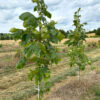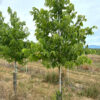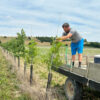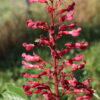For December, we’re taking a look at one of the more massive trees of eastern North America, the American beech, Fagus grandifolia. Fagus is a genus of only a dozen or so trees scattered throughout the Northern Hemisphere. It is the root genus of the family Fagaceæ, which also includes oaks (Quercus), chestnut (Castanea), and chinkapin (Castanopsis) amongst others. With a range from Nova Scotia west to Michigan and south to the Gulf Coast, along with scattered populations in central México, the American beech is the only beech native to the Western Hemisphere.
In its native range, the American beech is a climax tree, often co-existing with sugar (Acer saccharum) and black (Acer nigrum) maple, and a sign of mature forests. It prefers moist, acidic, well-drained soils and typically grows to its largest size on northern slopes and in bottomlands. It is one of the most shade-tolerant native trees. It has a dense and relatively shallow root system and does not tolerate either pollution or salt. It tends to be a slow-growing tree, but grows much faster when given ample water and sunlight.
(Scroll down to continue…)
Fagus grandifolia typically matures at a height of 15–20 m (50–70 ft), with individuals reaching as tall as 35 m (115 ft). The tallest living specimen is in Grundy County, Tennessee, with a height of 43.65 m (143 ft). In shape, and with adequate light, American beech gradually transforms from a pyramidal form in youth to a broad, upright-oval habit at maturity. It often retains lower limbs longer than many other native species. The oval, 8-12 cm (3-5 in) leaves emerge a bright-green fading to dark green as they open. The leaves have shallow, regularly-spaced teeth at the tips of prominent parallel veins and turn a bright coppery-yellow in autumn before fading to brown. Dead leaves are often retained until new growth emerges in spring. Fagus grandifolia has two distinctive traits that allow easy identification amongst its fellow native trees in winter. The first is the long and narrow winter buds which resemble miniature cigars. The second is the striking silver-grey bark which retains its smoothness throughout the life of the tree. This characteristic makes it somewhat notorious as a favored tree for vandals to carve initials and other graffiti.
American beech, like other beeches, is monoecious, with small paired female flowers and male catkins emerging shortly after the leaves. The fruit is the beechnut, a small triangular nut borne in groups of two or three and enclosed in a small oval bur. The bur splits after a hard freeze releasing the nuts, which are a favored food for many animals, including squirrels, ruffed grouse, wild turkeys, deer, and black bears. The wood of American beech is hard, dense, and pale, and commonly used for both flooring and furniture, the latter because the wood bends easily when steamed. Beech also makes for exceptional firewood, burning long and steady with little residue.
In the landscape, Fagus grandifolia is under-utilized, with its European cousin, F. sylvatica, being used in its stead. The European beech is more pollution-tolerant, and has a reputation for faster growth, but American beech is better suited to the mid-Atlantic as it is better adapted to our summer heat and humidity. Given adequate space and well-drained, moist, acidic soil, it is an outstanding choice for larger suburban and rural properties and development sites. Its graceful form and outstanding year-round beauty are a magnificent addition to the right project. White House Natives currently has quite a few 2½” to 3” caliper trees available for spring 2024. We encourage you to give this under-used native a try!






